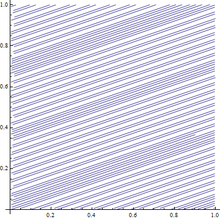Linear flow on the torus
In mathematics, especially in the area of mathematical analysis known as dynamical systems theory, a linear flow on the torus is a flow on the n-dimensional torus
which is represented by the following differential equations with respect to the standard angular coordinates (θ1, θ2, ..., θn):
The solution of these equations can explicitly be expressed as
If we represent the torus as we see that a starting point is moved by the flow in the direction ω = (ω1, ω2, ..., ωn) at constant speed and when it reaches the border of the unitary n-cube it jumps to the opposite face of the cube.

For a linear flow on the torus either all orbits are periodic or all orbits are dense on a subset of the n-torus which is a k-torus. When the components of ω are rationally independent all the orbits are dense on the whole space. This can be easily seen in the two dimensional case: if the two components of ω are rationally independent then the Poincaré section of the flow on an edge of the unit square is an irrational rotation on a circle and therefore its orbits are dense on the circle, as a consequence the orbits of the flow must be dense on the torus.
Irrational winding of a torus
In topology, an irrational winding of a torus is a continuous injection of a line into a two-dimensional torus that is used to set up several counterexamples.[1] A related notion is the Kronecker foliation of a torus, a foliation formed by the set of all translates of a given irrational winding.
Definition
One way of constructing a torus is as the quotient space of a two-dimensional real vector space by the additive subgroup of integer vectors, with the corresponding projection . Each point in the torus has as its preimage one of the translates of the square lattice in , and factors through a map that takes any point in the plane to a point in the unit square given by the fractional parts of the original point's Cartesian coordinates. Now consider a line in given by the equation y = kx. If the slope k of the line is rational, then it can be represented by a fraction and a corresponding lattice point of . It can be shown that then the projection of this line is a simple closed curve on a torus. If, however, k is irrational, then it will not cross any lattice points except 0, which means that its projection on the torus will not be a closed curve, and the restriction of on this line is injective. Moreover, it can be shown that the image of this restricted projection as a subspace, called the irrational winding of a torus, is dense in the torus.
Applications
Irrational windings of a torus may be used to set up counter-examples related to monomorphisms. An irrational winding is an immersed submanifold but not a regular submanifold of the torus, which shows that the image of a manifold under a continuous injection to another manifold is not necessarily a (regular) submanifold.[2] Irrational windings are also examples of the fact that the induced submanifold topology does not have to coincide with the subspace topology of the submanifold.[2]
Secondly, the torus can be considered as a Lie group , and the line can be considered as . Then it is easy to show that the image of the continuous and analytic group homomorphism is not a Lie subgroup[2][3] (because it is not closed in the torus – see the closed subgroup theorem) although, of course, it is still a group. It may also be used to show that if a subgroup H of the Lie group G is not closed, the quotient G/H does not need to be a submanifold[4] and might even fail to be a Hausdorff space.
Notes
^ a: As a topological subspace of the torus, the irrational winding is not a manifold at all, because it is not locally homeomorphic to
References
- ↑ D. P. Zhelobenko. Compact Lie groups and their representations.
- 1 2 3 Loring W. Tu (2010). An Introduction to Manifolds. Springer. p. 168. ISBN 978-1-4419-7399-3.
- ↑ Čap, Andreas; Slovák, Jan (2009), Parabolic Geometries: Background and general theory, AMS, p. 24, ISBN 978-0-8218-2681-2
- ↑ Sharpe, R.W. (1997), Differential Geometry: Cartan's Generalization of Klein's Erlangen Program, Springer-Verlag, New York, p. 146, ISBN 0-387-94732-9
Bibliography
- Anatole Katok and Boris Hasselblatt (1996). Introduction to the modern theory of dynamical systems. Cambridge. ISBN 0-521-57557-5.